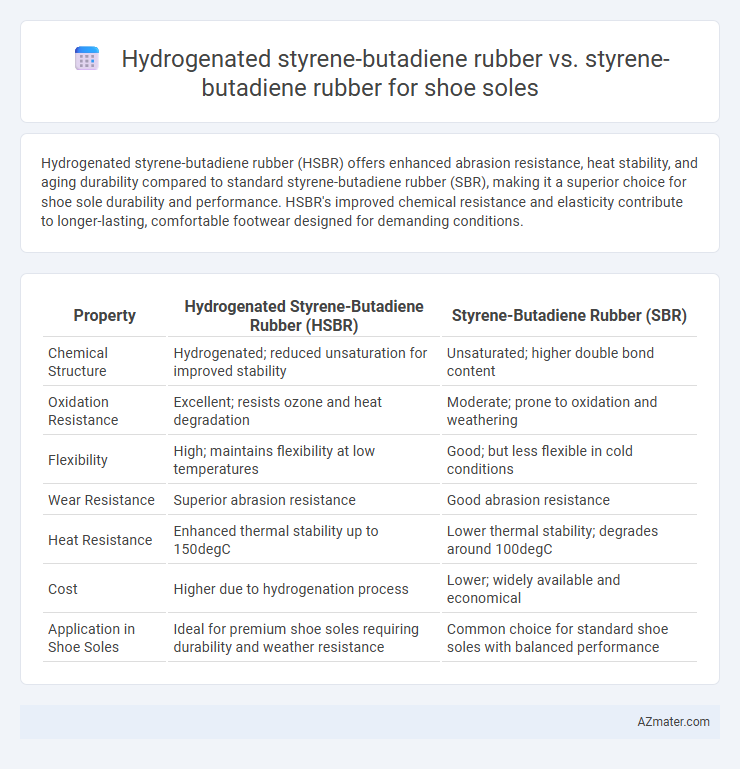Hydrogenated styrene-butadiene rubber (HSBR) offers enhanced abrasion resistance, heat stability, and aging durability compared to standard styrene-butadiene rubber (SBR), making it a superior choice for shoe sole durability and performance. HSBR's improved chemical resistance and elasticity contribute to longer-lasting, comfortable footwear designed for demanding conditions.
Table of Comparison
| Property | Hydrogenated Styrene-Butadiene Rubber (HSBR) | Styrene-Butadiene Rubber (SBR) |
|---|---|---|
| Chemical Structure | Hydrogenated; reduced unsaturation for improved stability | Unsaturated; higher double bond content |
| Oxidation Resistance | Excellent; resists ozone and heat degradation | Moderate; prone to oxidation and weathering |
| Flexibility | High; maintains flexibility at low temperatures | Good; but less flexible in cold conditions |
| Wear Resistance | Superior abrasion resistance | Good abrasion resistance |
| Heat Resistance | Enhanced thermal stability up to 150degC | Lower thermal stability; degrades around 100degC |
| Cost | Higher due to hydrogenation process | Lower; widely available and economical |
| Application in Shoe Soles | Ideal for premium shoe soles requiring durability and weather resistance | Common choice for standard shoe soles with balanced performance |
Introduction to Shoe Sole Materials
Hydrogenated styrene-butadiene rubber (HSBR) offers enhanced abrasion resistance and oxidative stability compared to traditional styrene-butadiene rubber (SBR), making it highly suitable for durable shoe sole applications. SBR remains widely used due to its excellent flexibility, good wear resistance, and cost-effectiveness in mass production of footwear soles. The hydrogenation process in HSBR reduces unsaturation in the polymer chain, significantly improving weather resistance and lifespan of shoe soles exposed to harsh conditions.
Overview of Hydrogenated Styrene-Butadiene Rubber (HSBR)
Hydrogenated Styrene-Butadiene Rubber (HSBR) is a chemically modified version of Styrene-Butadiene Rubber (SBR) with improved resistance to heat, ozone, and oxidation, making it ideal for durable shoe soles. HSBR offers superior mechanical strength and enhanced aging properties compared to conventional SBR, resulting in longer-lasting footwear performance. The hydrogenation process increases the material's chemical stability without compromising its flexibility and abrasion resistance, key factors for high-quality shoe sole applications.
Characteristics of Styrene-Butadiene Rubber (SBR)
Styrene-butadiene rubber (SBR) exhibits excellent abrasion resistance and good aging stability, making it ideal for durable shoe soles. Compared to hydrogenated styrene-butadiene rubber (HSBR), SBR maintains flexibility and impact resistance at lower temperatures, enhancing comfort and performance in footwear applications. Its cost-effectiveness and versatility in compounding allow for tailored mechanical properties to meet specific sole design requirements.
Mechanical Properties: HSBR vs SBR
Hydrogenated styrene-butadiene rubber (HSBR) offers superior mechanical properties compared to conventional styrene-butadiene rubber (SBR) for shoe sole applications, including enhanced tensile strength, abrasion resistance, and heat aging stability. The hydrogenation process reduces unsaturation in HSBR, resulting in better resistance to oxidative degradation and improved durability under high-stress conditions typical in footwear soles. In contrast, SBR exhibits higher flexibility but lower mechanical endurance and oxidative stability, making HSBR the preferred choice for high-performance shoe soles requiring extended service life.
Abrasion Resistance and Durability Comparison
Hydrogenated styrene-butadiene rubber (HSBR) exhibits superior abrasion resistance compared to standard styrene-butadiene rubber (SBR), making it more suitable for high-wear shoe sole applications. The hydrogenation process enhances the polymer's saturation level, improving oxidative stability and durability under repetitive mechanical stress. As a result, HSBR soles offer extended lifespan and maintain structural integrity better than SBR soles in demanding environments.
Flexibility and Comfort in Shoe Soles
Hydrogenated styrene-butadiene rubber (HSBR) offers enhanced flexibility and improved comfort in shoe soles due to its superior abrasion resistance and reduced gas permeability compared to standard styrene-butadiene rubber (SBR). This hydrogenation process increases polymer saturation, resulting in increased resilience and better cushioning, which reduces foot fatigue during prolonged wear. SBR soles provide good flexibility but lack the enhanced durability and softness that HSBR delivers, making HSBR a preferred choice for high-performance, comfortable footwear applications.
Weather and Aging Resistance: HSBR vs SBR
Hydrogenated styrene-butadiene rubber (HSBR) exhibits superior weather and aging resistance compared to standard styrene-butadiene rubber (SBR) due to its saturated polymer backbone, which enhances stability against heat, ozone, and UV exposure. HSBR's improved resistance to oxidative degradation extends shoe sole durability in harsh environmental conditions, reducing cracking and stiffness over time. This makes HSBR an ideal choice for high-performance footwear soles requiring long-lasting elastomeric properties under variable weather and aging stress.
Cost Efficiency and Production Scalability
Hydrogenated styrene-butadiene rubber (HSBR) offers enhanced chemical resistance and durability compared to regular styrene-butadiene rubber (SBR), impacting overall cost efficiency by potentially reducing replacement frequency despite higher initial material costs. SBR allows for more cost-effective production scalability due to its widespread availability and established manufacturing processes in shoe sole applications. Balancing HSBR's superior performance with SBR's lower raw material and processing costs is crucial for optimizing production budgets and meeting volume demands in footwear manufacturing.
Environmental Impact of HSBR and SBR
Hydrogenated styrene-butadiene rubber (HSBR) exhibits enhanced resistance to oxidation and ozone compared to styrene-butadiene rubber (SBR), resulting in longer shoe sole lifespan and reduced waste generation. The hydrogenation process in HSBR production consumes additional energy and chemicals, potentially increasing its environmental footprint relative to SBR, which is synthesized through a simpler polymerization method. However, HSBR's superior durability may offset initial environmental costs by decreasing the frequency of sole replacement and overall material consumption.
Conclusion: Choosing the Right Rubber for Shoe Soles
Hydrogenated styrene-butadiene rubber (HSBR) offers superior abrasion resistance, enhanced heat stability, and improved antioxidant properties compared to standard styrene-butadiene rubber (SBR), making it ideal for high-performance and durable shoe soles. SBR remains a cost-effective choice with good wear resistance and flexibility, suitable for everyday footwear requiring moderate durability and comfort. Selecting the right rubber depends on balancing performance needs, budget constraints, and the specific application environment of the shoe sole.

Infographic: Hydrogenated styrene-butadiene rubber vs Styrene-butadiene rubber for Shoe sole
 azmater.com
azmater.com